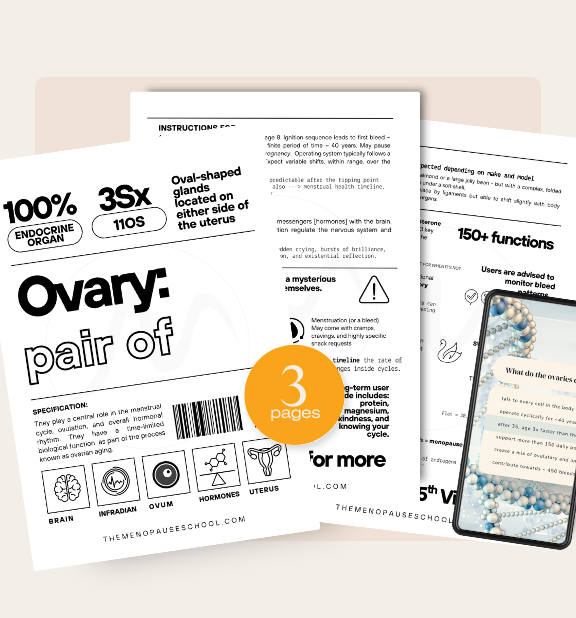Hormones Have No Gender
Prefer to read it later? Download a copy of this article HERE (no email required)
Why retiring the labels matters for science, practice, and education
Biologically, hormones are chemical messengers. They are molecules, not identities. Estradiol, progesterone, and testosterone exist in all humans, produced by multiple tissues including the gonads, adrenal glands, fat tissue, and even the brain. What differs is the relative concentration, rhythm, and interaction with receptors across the menstrual health timeline, life stage, or metabolic state — not the presence or absence of the hormone itself.
Is the gender labelling of sex hormones a key factor that prevents us from learning the whole truth about sex hormones from the start?
Why are commentators on human biology still using gender terms when describing hormones — particularly sex hormones?
Who benefits?
🔍 Why gender labelling persists
Historical legacy: Early 20th-century endocrinology was framed through sexual development and secondary sex characteristics. Researchers like Adolf Butenandt, who first isolated estradiol and progesterone, linked them to “female” traits, while testosterone was linked to “male” traits. This labelling stuck and shaped both science and public understanding.
Clinical shorthand: Medicine has often used gendered language for simplicity — “female hormones” or “male hormones” — even though it is biologically inaccurate and reinforces binary thinking.
Cultural inertia: The language of “male” and “female” hormones has been repeated for decades in textbooks, health campaigns, and media, so it feels familiar and intuitive, even though it misleads.
🧠 What’s the cost of this framing?
It’s not just semantics. Gendered language around hormones limits what we see, study, and support.
Research blind spots: Because estradiol is still framed as a “female hormone,” research often overlooks its wider roles in cardiovascular function, brain ageing, and immune regulation across all humans.
Public confusion: People believe testosterone “belongs to men” or estradiol “belongs to women,” which fuels stigma around normal variation and undermines education.
Clinical oversights: Practitioners trained in this binary language may overlook how hormonal rhythms — not just levels — influence health across the lifespan, regardless of gender.
📥 Who benefits?
Pharma: It’s easier to market testosterone gels as “for men” and estradiol creams as “for women.” Simplicity sells.
Institutions invested in binaries: Gendered categories reinforce long-standing medical and cultural frameworks that thrive on neat divisions.
Time-poor communicators: Gender labels are an easy shortcut. They avoid complexity — but at the expense of truth.
✨ The truth we missThe story of sex hormones (particularly the three mentioned) is not a “male vs female” story. It’s a story of rhythm, timing, and systemic influence.
All 3 play a role in all 11 functional networks called operating systems, in every human body.
Combined they have over 150 functions whether or not someone menstruates.
When we keep calling them “male” and “female” hormones, we obscure that bigger picture. We limit understanding to the pelvis, when their influence runs from neurons to bones to the immune system.
(You’ll see exactly what I mean inside the download you can grab below ⬇️ )
🌀 A new lens
It’s time to retire the gendered labels. Not to deny the differences in physiology between people with ovaries and people with testes, but to tell the fuller story: hormones are universal messengers, shared across humanity, playing diverse roles beyond sex characteristics.
The payoff is significant: research becomes more accurate, clinical care more effective, and stigma begins to fall away. Professionals and clients alike can finally see hormones for what they truly are — part of the collective language the body uses to stay alive and adapt.
Hormones don’t need a gender. What they need is context, respect, and an end to the 90-year-old shorthand that no longer serves us.
Removing the gender labelling doesn’t erase the importance of rhythms, timelines, or differences in physiology — but it does open the door to a more truthful, inclusive, and biologically precise conversation.
✨ The bigger question
Does the current school-based sex hormone misinformation and misdirection contribute to the tiny crack that eventually becomes the gender health and education gap?
If there were early interventions to realign the correct biological facts for everyone, could we start to zip-up the void before it begins?
Hormones have no gender. Let’s start there and see what happens.
📥 The quick-read to keep on hand
The Ovary User Guide is a short, sharp, 3-minute read designed to:
Give a snapshot of the ovaries’ physical features, functions, and rhythms.
Present biology in a playful but precise style, with quick facts, cues, and memorable phrasing.
Surprise professionals who thought they already “knew” about the ovaries.
Hint at the bigger menstrual health timeline without unpacking it all.
Think field guide meets quick-reference card. Skim it once, and you’ll start spotting ovarian clues in your clients the very same day. Scroll down to grab a copy now!
If you are interested in learning more about The Menopause Doula Training course click HERE
If you join before the end of August there’s a 20% off coupon code: AUG20



